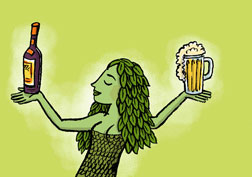
From CBS News:
California Wineries Try To Set An Example Of What's Possible With Existing Technologies.
(AP) John Conover was looking for the best place to grow the Napa Valley's famous cabernet sauvignon grapes. Turns out the same southwest-facing, sunny hillside that gives him great grapes also raises a mean crop of solar panels.
"We wanted to be as green as we can be," says Conover, a partner in the Cade winery, which is on track for Gold certification under the U.S. Green Building Council's LEED (Leadership in Energy and Environmental Design).
Green wine is catching on.
Read more ....


















